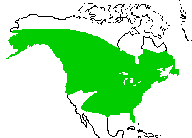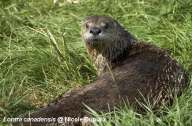 |
Last Update:
Sunday February 22, 2015 |
| •[Home] | [Site Map] | [Contact Us]• | |
| [Home] | [Members] | [News] | [Bulletin] | [Q & A] | [Species] | [Library] |
Lontra canadensis (Shrebber, 1776), the North American River Otter (currently being revised)
|
|
DescriptionA large, sturdy otter, 1.5m long, weighing 15kg. The paws are webed to the end, with tufts of hair under the toes; the claws are strong. The rhinarium is large and diamond-shaped, the muzzle broad and well-whiskered. In general, this species is dark brown on the upper surface, sometimes with frosting, and paler below and on the face. There is a great deal of regional variation, with many subspecies. This species shows variable sociability - some animals are solitary, others live in fairly stable pairs, some families join together while hunting, and all of this can vary seasonally. These otters exhibit delayed implantation - while the gestation is around the normal otter 63 days, breeding takes place once a year in late winter/early spring, depending on latitude. This species also has a characteristic "chuckle" vocalisation. These otters mainly eat a wide variety of fish, but in different locations and seasons, amphibia, muskrats and birds may be important. Crayfish and mussels are also taken. Liers reported that his many pet otters had a passion for blueberries and would patiently strip a bush if encountered during a walk. HabitatThese otters are found in a huge variety of habitats from coastal waters, swamps and lowland rivers, creeks and streams to mountainous areas - wherever there is sufficient food and suitable den sites. DistributionNorth America: Canada (Alberta; British Columbia; Labrador; Manitoba; New Brunswick; Newfoundland; Northwest Territories; Nova Scotia; Nunavut; Ontario; Quebec; Saskatchewan; Yukon) and USA ( (Alabama; Alaska; Arizona; Arkansas; California; Colorado; Connecticut; Delaware; District of Columbia; Florida; Georgia; Idaho; Illinois; Indiana; Iowa; Kansas; Kentucky; Louisiana; Maine; Maryland; Massachusetts; Michigan; Minnesota; Mississippi; Missouri; Montana; Nebraska; Nevada; New Hampshire; New Jersey; New Mexico; New York; North Carolina; North Dakota; Ohio; Oklahoma; Oregon; Pennsylvania; Rhode Island; South Carolina; South Dakota; Tennessee; Texas; Utah; Vermont; Virginia; Washington; West Virginia; Wisconsin; Wyoming) Conservation StatusRed List Category LC (Least Concern) Improvements in water quality and trapping management, along with a reintroduction effort has enabled this species to recover from the low numbers of the early 19th century. (Source: IUCN Red List) Current ConcernsSince 1976 over 4,000 otters have been reintroduced among 21 states. Also, 29 states and all Canadian provinces except Prince Edward Island have viable populations that sustain annual harvests. Current harvest strategies do not pose a threat to maintaining otter populations. However, harvest may limit expansion of otter populations in some areas. Oil spills present a localized threat to otter populations, especially in coastal areas. Water pollution and other degradation of aquatic and wetland habitats may limit distribution of otters and pose long-term threats if enforcement of water quality standards are not maintained and enforced. Acid drainage from coal mines is a persistent water quality problem in some areas that eliminates otter prey prevents thereby inhibits recolonization or expansion of otter populations. Recently, there has been discussion of the long-term genetic consequences of reintroduction projects on remnant otter populations (Serfass et al. 1998). The threat of disease to wild otter populations is poorly understood and has received little study (Serfass et al. 1995). Similarly, many perceived threats to otters such as pollution and habitat alterations have not been rigorously evaluated. Additional research is needed to clearly delineate the impact that various forms of water pollution, agricultural and other development along riparian habitats, industrial and housing development in coastal areas, cumulative impacts related to loss or alterations of wetlands, large flood control structures, and interactions that these and other factors have on otter populations. Threats to otter populations in North America vary among regions and are influenced by type, distribution, and density of aquatic habitats and characteristics of human activities. Leading ResearchersTom Serfass, Paul Polechla, Wayne Melquist, Key PublicationsGeneral
Useful Links
|
| [Copyright � 2006 - 2011 IUCN OSG] | [Home] | [Site Map] | [Contact Us] |


